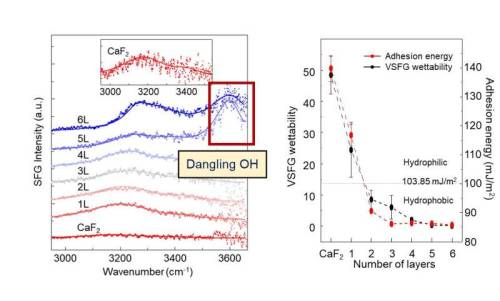#interfaces
Graphene controls surface magnetism at room temperature
Typically research has focused on the effects induced by different materials in graphene. Convinced that this is only half the story, Dr Zeila Zanolli turned the tables to look at the proximity effects of graphene on magnetic semiconducting substrates. Using first principles calculations she observes a switching of internal spin alignment from antiferromagnetic to ferromagnetic. Persisting close to room temperature, her findings could find applications in magnetic memories or spin filters.
[…]
In a refreshing change of perspective, theoretical physicist Dr Zeila Zanolli has looked at the proximity effects of graphene on a magnetic semiconducting substrate, finding it to affect the substrate’s magnetism down to several layers below the surface. Her paper was published on 5 October in Physical Review B. She was also one of three recipients of the first MaX Prize for frontier research in computational materials science.
Post link
Scientists measure temperature under shock conditions
Temperature is tough to measure, especially in shock compression experiments. A big challenge is having to account for thermal transport—the flow of energy in the form of heat.
To better understand this challenge, researchers from Lawrence Livermore National Laboratory (LLNL) have taken important steps to show that thermal conduction is important and measurable at high pressureandtemperature conditions in these types of experiments, according to a paper recently published in the Journal of Applied Physics. The paper’s authors are David Brantley, Ryan Crum and Minta Akin.
“We need better temperature measurements because understanding rocky-type planetary materials’ high temperature and pressure behavior is key to developing better models of Earth and other terrestrial exoplanets,” said David Brantley, LLNL physicist and lead author of the paper.
Brantley said that depending on how iron conducts heat at Earth’s core pressure and temperatures, the planet’s solid inner core could be around 500 million to several billion years old.
Post link
Measuring the ‘wettability’ of graphene and other 2D materials
Wettability of a material is the ability of a liquid to maintain contact with a solid surface, and it is proportional to hydrophilicity and inversely proportional to hydrophobicity. It is one of the most important properties of a solid, and understanding the wettability of different substrates is essential for various industrial uses, such as desalination, coating agents, and water electrolytes.
So far, studies on the wettability of substrates have mainly been measured at the macroscopic level. The macroscopic measurement of wettability is typically determined by measuring the water contact angle (WCA), which is the angle a water droplet makes with respect to the surface of the substrate. However, it is currently very difficult to accurately measure what happens at the interface between a substrate and water at the molecular level.
Currently used microscopic measurement techniques, such as reflection-based infrared spectroscopy or Raman spectroscopy, are incapable of selectively observing the interfacial water molecules. Since the number of water molecules in the entire bulk of the liquid is much larger than the molecules that are making contact with the surface, the signal of interfacial water molecules is obscured by the signal of water molecules in the bulk liquid.
Post link
This is Chomsky’s formulation of the Strong Minimalist Thesis, i.e. the working hypothesis underlying the Minimalist Program.
Language = the narrow syntax, i.e. the computational system that builds structure using items from the lexicon. Structure is built using simple, yet powerful, operations.
The narrow syntax builds the structure and then the structure goes off to other systems with which the narrow syntax shares an interface. These other systems (of which Chomsky assumes there are two, one semantic, the other to do with production (speech or signs etc.)) are systems in their own right. This means they can only ‘see’ and deal with certain things. Therefore, the narrow syntax must produce something that an interface system can ‘read’. Since there are two interface systems, the narrow syntax must produce structures which are legible to both interface systems. The interface systems are different and so require different ‘legibility conditions’ to be met. The narrow syntax thus faces a problem of how to satisfy these conditions simultaneously. The hypothesis being followed in the Minimalist Program is that the narrow syntax that we have is an optimal solution to this problem – it meets the conditions of the interface systems in (one of) the best possible ways.
The Strong Minimalist Thesis is not a doctrine – it is a working hypothesis. It’s a bit like the assumption that natural phenomena can be modelled by mathematics – you assume an ideal, see how far the natural phenomenon matches the ideal, identify the areas where it does and does not, then return for more hypothesising. By using the Strong Minimalist Thesis as a working hypothesis linguists (of course this only applies to linguists who make the same assumptions as Chomsky) can try to establish:
(1) The ‘legibility conditions’ of the interface systems.
(2) The extent to which the narrow syntax does meet these conditions in some ‘optimal’ way.
(3) The extent to which the narrow syntax does NOT meet these conditions in some ‘optimal’ way.
(4) Reasons for why language may be optimal/sub-optimal.
Hopefully that has shed some light on what is at first glance…and second, third, fourth glances etc…a pretty obscure little sentence.



